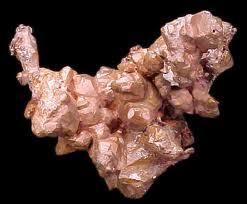|
|
Copper is a reddish metal with a face-centered cubic crystalline structure. It reflects red and orange light and absorbs other frequencies in the visible spectrum, due to its band structure, so it as a nice reddish colour. It is malleable, ductile, and an extremely good conductor of both heat and electricity. It is softer than iron but harder than zinc and can be polished to a bright finish. It is found in group Ib of the periodic table, together with silver and gold. Copper has low chemical reactivity. In moist air it slowly forms a greenish surface film called patina; this coating protects the metal from further attack. Applications Most copper is used for electrical equipment (60%); construction, such as roofing and plumbing (20%); industrial machineri, such as heat exchangers (15%) and alloys (5%). The main long established copper alloys are bronze, brass (a copper-zinc alloy), copper-tin-zinc, which was strong enough to make guns and cannons, and was known as gun metal, copper and nichel, known as cupronickel, which was the preferred metal for low-denomination coins. |
